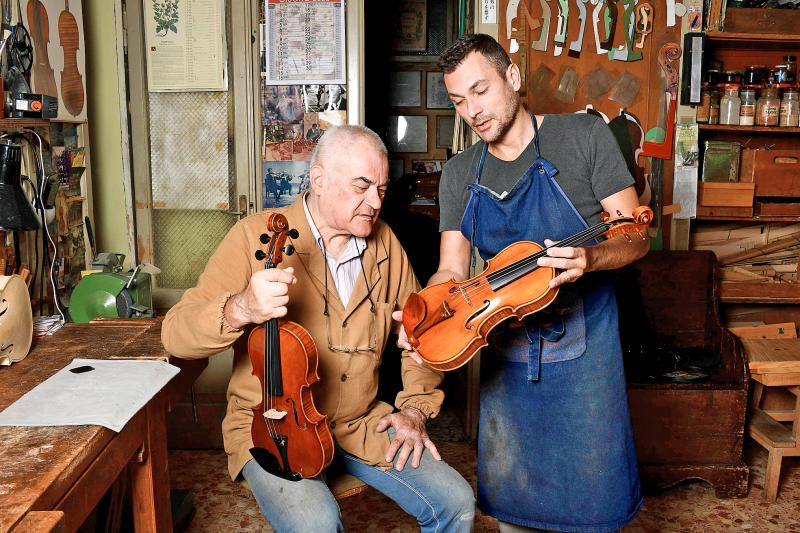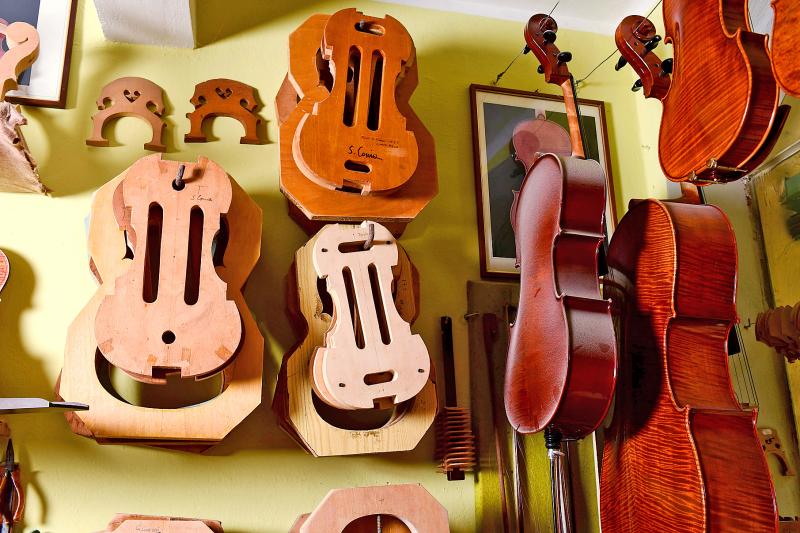Working in the shadow of the great masters, the violinmakers of Italy’s Cremona are valiantly fighting a shrinking market and foreign competition as they seek perfection, one violin at a time.
The birthplace of Stradivarius, Cremona is a veritable laboratory for luthiers from all over the world, where violin workshops seem to be everywhere you look.
Stefano Conia’s studio — just one of the 160 in the northern Italian city of 70,000 inhabitants — has not changed for decades.

Photo: AFP
It is situated at the back of a flower-filled courtyard, and this native Hungarian, one of the doyens of Cremonese violinmakers, heads there every day, despite retiring nearly 10 years ago.
“If I stopped making violins, life for me would be over. Every day I’m here in the workshop. It’s an antidote to old age,” said a smiling Conia, 74, whose father crafted violins and whose son is also pursuing the family tradition.
Conia’s workbench faces that of his son’s. Both are covered with files, clamps, compasses, brushes and small saws. Wooden planks are laid on the floor.

Photo: AFP
“Going into violin-making was a natural choice,” said Conia’s son, Stefano, known as “the youngster” who began handling tools at the age of seven or eight.
He spent his childhood in the workshop his father opened in 1972, two months before his birth.
“I would play with the wood and the musicians would come and buy their violins and play,” said the younger Conia. “It’s always been a special atmosphere, which I really liked.”
For the Conias, the violins lovingly made from flamed maple or spruce are more than just instruments — they become family.
“The instruments are a bit like children. They live thanks to the energy we give them, it is a part of us that will continue to live after our death,” Stefano Conia said.
Like the Conias, the majority of Cremona’s luthiers are foreigners. Many came to study at the Cremona International Violin Making School and stayed on.
“The school was started in 1938, the first teachers were foreigners and the students come from all over the world. There is a saying that ‘Nobody is a prophet in his own country’ and it’s true that we, Cremonese violinmakers, are really few and far between,” said Marco Nolli, 55, one of this exclusive club.
Of the one-third of Cremona’s violinmakers who are Italian, only about 10 percent come from Cremona, he said.
Benedicte Friedmann, a 45-year-old from France, has been living in “the cradle of violin-making” for about 20 years. “Coming to Cremona was — and maybe it’s a bit pretentious to say this — like walking in the footsteps of the greatest, Stradivarius, Guarneri, Amati,” she said, referring to the city’s most revered craftsmen of centuries past.
“Being a luthier here means being able to devote yourself 100 percent to creating instruments, and the more you do, the better you become,” Friedmann said.
In France, to earn a living as a violinmaker, many people do repairs, re-hair bows or sell accessories, which leaves them little time for their art, she said.
However, the situation is not always simple for the violinmakers of Cremona, who enjoyed growth in the 1960s-1980s, before things got tougher.
“Our market, which is an elite market, has shrunk. We are facing a very serious problem,” said Giorgio Grisales, president of the artisans’ consortium.
Fewer performances and musical venues and the preference of seasoned violinists for antique instruments from the 18th and 19th centuries have hurt the niche industry. Even before COVID-19 swept through northern Italy, Grisales said that “the sector was in trouble because of ruthless competition from China and Eastern Europe.”
China is the world’s leading producer of bowed instruments with US$77.8 million in exports last year, or 1.5 million instruments, more than half of the world market, according to the International Trade Centre.
Italy is in fifth position, with 4.6 percent of world exports, behind the UK and Germany, but ahead of France. Italy’s main customers are Japan and the US.
Italian violinmakers must contend with counterfeit instruments in the marketplace, some built elsewhere and advertised as Cremonese, but above all competition comes from lower priced violins. Master instruments start at 25,000 euros (US$27,943), although others of fine quality can sell for about 10,000 euros less, Grisales said.
However, for 200 euros or less, it is possible to buy a Chinese violin, bow and case.
“They are economic instruments, made in series, and intended for those who are beginning to study,” baroque violinist Fabrizio Longo said.
Friedmann, the French violinmaker, said that the process of making a violin in China is for the most part vastly different from the craftsmanship she and others in Cremona engage in.
“They are handmade, but 10 violinmakers work every day on the same parts. It’s a line job and at the end you get an assembly,” she said. “There’s no uniqueness, no authenticity.”
In Cremona, Grisales said that it takes at least 300 hours to make a violin, or between two to three months.
Another challenge for the luthiers is to stand out among the Cremonese competition.
“Getting known is a bit laborious,” while the search for orders “is a permanent quest,” Friedmann said.
Some violinmakers have been able to offer lower prices — hurting fellow luthiers — by working on the black market and avoiding high taxes.
Despite these challenges, Friedmann said that the concentration of violinmakers in Cremona creates a healthy environment of emulation and the desire to excel.
“When I’m asked which is the most beautiful instrument I’ve made, for me it’s always the next one,” she said.

Application-specific integrated circuit designer Faraday Technology Corp (智原) yesterday said that although revenue this quarter would decline 30 percent from last quarter, it retained its full-year forecast of revenue growth of 100 percent. The company attributed the quarterly drop to a slowdown in customers’ production of chips using Faraday’s advanced packaging technology. The company is still confident about its revenue growth this year, given its strong “design-win” — or the projects it won to help customers design their chips, Faraday president Steve Wang (王國雍) told an online earnings conference. “The design-win this year is better than we expected. We believe we will win

Intel Corp chief executive officer Lip-Bu Tan (陳立武) is expected to meet with Taiwanese suppliers next month in conjunction with the opening of the Computex Taipei trade show, supply chain sources said on Monday. The visit, the first for Tan to Taiwan since assuming his new post last month, would be aimed at enhancing Intel’s ties with suppliers in Taiwan as he attempts to help turn around the struggling US chipmaker, the sources said. Tan is to hold a banquet to celebrate Intel’s 40-year presence in Taiwan before Computex opens on May 20 and invite dozens of Taiwanese suppliers to exchange views

Chizuko Kimura has become the first female sushi chef in the world to win a Michelin star, fulfilling a promise she made to her dying husband to continue his legacy. The 54-year-old Japanese chef regained the Michelin star her late husband, Shunei Kimura, won three years ago for their Sushi Shunei restaurant in Paris. For Shunei Kimura, the star was a dream come true. However, the joy was short-lived. He died from cancer just three months later in June 2022. He was 65. The following year, the restaurant in the heart of Montmartre lost its star rating. Chizuko Kimura insisted that the new star is still down

While China’s leaders use their economic and political might to fight US President Donald Trump’s trade war “to the end,” its army of social media soldiers are embarking on a more humorous campaign online. Trump’s tariff blitz has seen Washington and Beijing impose eye-watering duties on imports from the other, fanning a standoff between the economic superpowers that has sparked global recession fears and sent markets into a tailspin. Trump says his policy is a response to years of being “ripped off” by other countries and aims to bring manufacturing to the US, forcing companies to employ US workers. However, China’s online warriors